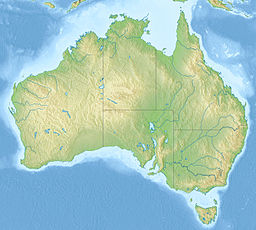
Lesueur National Park is a national park straddling the boundary between the Wheatbelt and Mid West regions of Western Australia, 211 km north of Perth. The park was gazetted in 1992. It includes two mesas known as Mount Lesueur and Mount Michaud, and supports a highly diverse flora.
The Pilbara is a large, dry, thinly populated region in the north of Western Australia. It is known for its Aboriginal peoples; its ancient landscapes; the red earth; and its vast mineral deposits, in particular iron ore. It is also a global biodiversity hotspot for subterranean fauna.
Cootes Paradise is a property of the Royal Botanical Gardens at the western end of Lake Ontario, and a remnant of the larger 3700 acre Dundas Marsh Crown Game Preserve established by the Province of Ontario in 1927. It is a 600 hectare environmental protection and education area, dominated by a 4.5km long rivermouth wetland, representing the lake's western terminus. It is found on the west side of Hamilton Harbour and is located in the municipality of Hamilton, Ontario, Canada.

The McArthur River mine is a zinc-lead mine, situated about 70 kilometres southwest of Borroloola, near the Gulf of Carpentaria in the northeastern Northern Territory, Australia. It is operated by McArthur River Mining (MRM), a subsidiary of the Swiss mining company Glencore. Although discovered in the 1950s, when it was originally called the HYC or "Here's Your Chance" deposit, it only opened as a mine in 1995. Initially an underground mining operation, the mine has been converted to open-cut.
Rosslyn Hill Mining Pty Ltd operates Paroo Station Mine at Wiluna in Western Australia.

The Fortescue River is an ephemeral river in the Pilbara region of Western Australia. It is the third longest river in the state.

The Edithvale-Seaford Wetlands is a collection of principally freshwater swamps and marshlands totalling 261 hectares in southeastern Melbourne, Victoria, Australia, about 30 km (19 mi) southeast of Melbourne CBD. It is the largest natural wetland of its type in the Port Phillip and Western Port basins, and is all that remains of the historic Carrum Carrum Swamp, which once covered more than 4,000 hectares from present-day Mordialloc in the north to Frankston in the south.

The Cloudbreak mine is an iron ore mine located in the Pilbara region of Western Australia, 89 kilometres west-south-west of Nullagine, in the Chichester Range.
The Christmas Creek mine is an iron ore mine located in the Pilbara region of Western Australia, 61 kilometres south-south-west of Nullagine, in the Chichester Range.

Lake Gnangara is the most southerly of the Wanneroo wetlands in metropolitan Perth, Western Australia.
The Roy Hill mine is an iron ore mine in the Chichester Range in the Pilbara region of Western Australia, located 115 kilometres (71 mi) north of Newman and 277 kilometres (172 mi) south of Port Hedland. With indicated and inferred reserves of more than 2.4 billion tonnes, it is expected to become one of the largest mining projects in Australia. Mining operations will produce 55 million tonnes of iron ore per annum with an operating life of more than 20 years.

The Cheetham Wetlands are 420 hectares of artificial and natural lagoons, created on old salt works land on the western shores of Port Phillip Bay, Australia. The wetlands are approximately 20 kilometres (12 mi) southwest of Melbourne, and sit within the Municipal Councils of Hobsons Bay and Wyndham City.
The Iron Valley mine is a small iron ore mine located in the Pilbara region of Western Australia, 75 kilometres (47 mi) northwest of Newman, 270 kilometres (170 mi) south of Port Hedland, and 10 kilometres (6.2 mi) east of the Yandicoogina mine.

Scott River is a river in the south west of Western Australia, a tributary to the Blackwood River where it joins just east of Molloy Island. It is partly located within Scott National Park.
Roy Hill Station is a pastoral lease and cattle station, located about 18 kilometres (11 mi) south of the Roy Hill mine.
The Eliwana mine is an iron ore mine operated by the Fortescue Metals Group (FMG) and located in the Pilbara region of Western Australia, 90 kilometres west of Tom Price. The mine forms the core of the company's Western Hub, one of three of its active mining areas, together with the Chichester Hub and the Solomon Hub.

The Firetail mine is an iron ore mine operated by the Fortescue Metals Group (FMG) and located in the Pilbara region of Western Australia, 60 km (37 mi) north of Tom Price. The mine is part of the company's Solomon Hub, one of three of its active mining areas, together with the Chichester Hub and the Western Hub.

The Kings Valley mine is an iron ore mine operated by the Fortescue Metals Group (FMG) and located in the Pilbara region of Western Australia, 60 km (37 mi) north of Tom Price. The mine, along with Firetail mine, is part of the company's Solomon Hub, one of three FMG's mining areas, the others being the Chichester Hub and the Western Hub.

The Roy Hill railway, officially the Roy Hill Infrastructure railway, owned and operated by Hancock Prospecting, is a private rail network in the Pilbara region of Western Australia built to carry iron ore.
The following is a maintained list of contemporary Australian environmental and cultural incidents that have resulted in destroyed, degraded or damaged notable cultural or environmental items.













